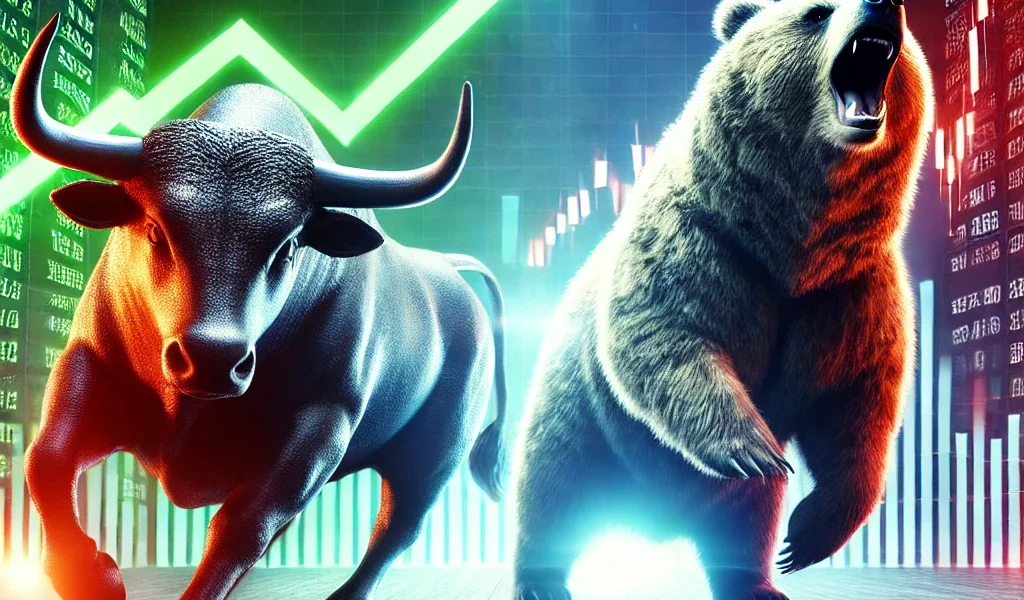Introduction
Stock markets experience cyclical trends characterized by periods of growth and decline. Two key market conditions, bull markets and bear markets, define the overall direction of the market and significantly impact investment strategies. Understanding these cycles and their key indicators helps investors make informed financial decisions, mitigate risks, and capitalize on opportunities.
This article explores the differences between bull and bear markets, key indicators to identify them, and strategies for navigating each phase effectively.
What is a Bull Market?
A bull market is characterized by rising stock prices, economic expansion, and high investor confidence. During a bull market:
- Stock prices rise steadily over an extended period.
- GDP growth is strong, and unemployment rates are low.
- Investor sentiment is optimistic, leading to increased buying activity.
- Corporate profits improve, boosting stock valuations.
- Market indices, such as the S&P 500, NASDAQ, or Dow Jones, show sustained upward trends.
Indicators of a Bull Market
- Rising GDP: A strong economy with increasing gross domestic product (GDP) signals a growing market.
- Low Unemployment: Job creation leads to higher disposable income, boosting consumer spending and investments.
- Higher Corporate Earnings: When companies report strong earnings, investors gain confidence, leading to higher stock valuations.
- Increased Market Liquidity: More money flowing into equities indicates investor confidence and strengthens the market.
- Strong Investor Sentiment: High demand for stocks drives prices up, reinforcing a bull market trend.
How to Invest in a Bull Market
- Buy and Hold Strategy: Long-term investors can benefit from staying invested in high-quality stocks.
- Growth Stocks: Investing in companies with high growth potential can yield significant returns.
- Diversification: Spreading investments across sectors reduces risk while capitalizing on market growth.
- Ride the Momentum: Short-term traders often capitalize on bullish trends by buying strong-performing stocks and holding them during the upward momentum.
What is a Bear Market?
A bear market occurs when stock prices decline by 20% or more from recent highs, leading to economic downturns and pessimistic investor sentiment. Characteristics of a bear market include:
- Falling stock prices over an extended period.
- Economic contraction and declining GDP.
- Higher unemployment rates as companies cut costs.
- Lower investor confidence, leading to selling pressure.
- Market volatility, causing sudden fluctuations in stock prices.
Indicators of a Bear Market
- Declining GDP: A slowdown in economic activity often correlates with falling stock prices.
- Rising Unemployment: Job losses indicate economic stress, leading to decreased consumer spending and investment.
- Decreasing Corporate Earnings: Weak financial performance by companies signals trouble for the stock market.
- High Inflation or Interest Rates: Rising costs reduce company profits and impact consumer purchasing power.
- Increased Volatility: Markets become unpredictable, with sharp price swings and uncertainty.
How to Invest in a Bear Market
- Defensive Stocks: Investing in consumer staples, utilities, and healthcare sectors, which tend to be resilient during downturns.
- Dividend Stocks: Reliable dividend-paying stocks can provide consistent income even when prices fall.
- Hedging Strategies: Using options, bonds, and alternative investments to minimize risk.
- Stay in Cash or Bonds: Holding cash or investing in safe assets preserves capital and provides flexibility for future opportunities.
- Long-Term Perspective: Bear markets are temporary; long-term investors often benefit from staying invested and averaging down their stock holdings.
Comparing Bull and Bear Markets
| Feature | Bull Market | Bear Market |
|---|---|---|
| Stock Prices | Rising | Declining |
| Investor Sentiment | Optimistic | Pessimistic |
| Economic Growth | Expanding | Contracting |
| Unemployment | Low | High |
| Market Liquidity | High | Low |
| Investment Strategy | Growth Stocks, Buy & Hold | Defensive Stocks, Hedging |
Factors Influencing Market Trends
While bull and bear markets are driven by economic conditions, several external factors can influence market trends:
- Federal Reserve Policies: Interest rate changes affect borrowing, spending, and investment behavior.
- Geopolitical Events: Wars, trade conflicts, and political instability impact investor confidence.
- Inflation Trends: Rising inflation can erode purchasing power and corporate profits.
- Technological Innovations: Advancements in AI, automation, and other industries can trigger new market trends.
- Global Pandemics: Health crises, such as COVID-19, can disrupt economies and financial markets.
Conclusion
Understanding bull and bear markets is crucial for successful investing. Recognizing key indicators, economic trends, and external influences allows investors to adapt their strategies and make informed decisions. While market cycles are inevitable, those who stay informed and adjust their investments accordingly can navigate volatility and maximize long-term gains.
By diversifying portfolios, employing risk management strategies, and maintaining a disciplined approach, investors can thrive in both bull and bear markets. The key is to remain patient, well-informed, and adaptable to changing market conditions.



